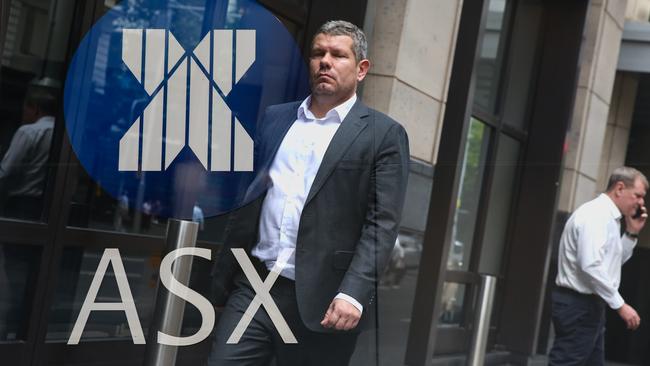
That stems in some respects from the ASX relying on the 30-year-old Clearing House Electronic Sub-register System (CHESS), the clearing and settlement system that underpins the operation of the exchange.
The ASX on Friday declared an “emergency situation” under the standard payments provider deed, when it was unable to settle and clear trades from Wednesday. The issue meant stockbrokers, market participants and investors were left reeling and regulators had to again intervene.
It’s another damaging situation for the ASX to navigate and there is little to no room for error now that the exchange has assured stakeholders it will be able to settle two days of trades on Monday rather than one, with no issues.
A series of crisis meetings ensued over the weekend, but it was some time before a data file error was identified, which was hindering the settlement of trades. Given our market functions on a trade occurring then settlement happening two days after that, it meant Wednesday’s trades were left hanging as the ASX scrambled to figure out the problem.
The issue meant the ASX came perilously close to having to delay the market open on Monday or even having to stop trading altogether or halting settlement for another day. What would have occurred if this technical issue had cropped up on a Monday evening and the ASX didn’t have the weekend to resolve it?

It was only on Sunday afternoon that Friday’s technical matter was resolved, and participants were fully briefed at 5pm about what Monday would bring.
Surely, we should expect better from our market operator than this? Ageing technology aside, our financial markets should function in an efficient and resilient manner with any issues dealt with expeditiously given what’s at stake.
One market participant described the data file error as a “bloody disaster”, asking how the ageing CHESS platform would fare over the next five years.
Another participant said: “We are the laughing stock of financial markets” and cautioned the latest incident showed there were risks the ASX may not meet the 2029 deadline for latest CHESS upgrade.
The same participant said: “The ASX has failed the market. It’s very lucky it is a quiet time of year. They were obviously struggling to figure out what was going on.”
While it was crisis management at the ASX over the weekend, several executives were working remotely given the time of year.
ASX chief executive Helen Lofthouse led the crisis meetings over the weekend, but it was unclear whether she was in Australia. Contacted by this column she said she was “actively involved” in the process but refused to answer any further questions including about her whereabouts.
Problems of this scale and magnitude that threaten the operation and integrity of our financial markets require leadership and an understanding of the knock-on effects for stockbrokers, registries and the end investor who is relying on trades to settle.
Let’s not forget the latest CHESS upgrade project comes after the prior plan – which drew on blockchain technology – was shelved and associated with $250m in write-downs. It also led to landmark legal action by the corporate regulator against the ASX, relating to its disclosures to investors regarding the bungled project. ASX chairman Damian Roche finally saw the writing on the wall in September and stepped down the following month, handing the baton to David Clarke.

While technical glitches happen at market operators, the ASX has had a terrible run in recent years. In 2020, after a Covid-19 induced trading volume spike, an ASX team worked Saturday and Sunday to process the overspill of trading volumes that weren’t able to be managed. There was also a disastrous outage in November 2020 triggered by a software issue from a new Nasdaq release, which forced the ASX to close the market for almost an entire trading day.
The ASX’s track record recently in getting the basics right has been terrible, and further accountability needs to follow. Compare what happened here over the weekend to an issue in the US.
The New York Stock Exchange suffered a technical issue in June that affected the trading of dozens of stocks, but the glitch was resolved relatively quickly.
The ASX’s legacy systems are creaky and plagued by problems and market participants are losing confidence in the operator’s abilities. This situation needs to be rectified if the ASX is to continue to hold the central role in the functioning of Australia’s financial markets.
As the corporate regulator forges ahead with its legal action against ASX over the initial CHESS upgrade more will become known about the inner workings of the exchange and the inherent difficulties involved in technology transformation programs.
Going into 2025 the ASX should figure out a credible and reliable way to ensure our markets can function efficiently while it awaits the latest iteration of the CHESS upgrade.
In the clear
Australia’s big four banks, which dominate the sector in New Zealand, will be collectively relieved that regulators across the Tasman have closed a string of investigations into the alleged manipulation of the sale of government bonds.
The Financial Markets Authority was probing two key cases earlier this year, but this column understands after conducting market inquiries the regulator has closed those matters. An additional case was referred to the FMA in July, it was assessed and also closed.
That comes as the Australian Securities & Investments Commission conducts an investigation into how ANZ managed a $14bn government bond issuance in this market last year. ASIC is looking at irregular trading and activity around the issuance, while the prudential regulator is closely scrutinising ANZ’s broader management of non-financial risks.
Whichever way that probe goes, market integrity and trading conduct is set to be a topic of focus again in 2025.
The International Organization of Securities Commissions (IOSCO) just last month released a detailed consultation report providing a definition of pre-hedging and proposing recommendations to guide regulators in their assessment of what constitutes “acceptable pre-hedging practices and managing the associated conduct risks effectively”. IOSCO – which brings together securities regulators from around the world – wants feedback on the proposed definition and recommendations, by February 21.
In 2017, the FMA issued guidance to clarify its expectations around trading conduct and controls for banks participating in trading in that part of the market.






The ASX may have averted a major crisis over the weekend, but the situation the market operator finds itself in is farcical.